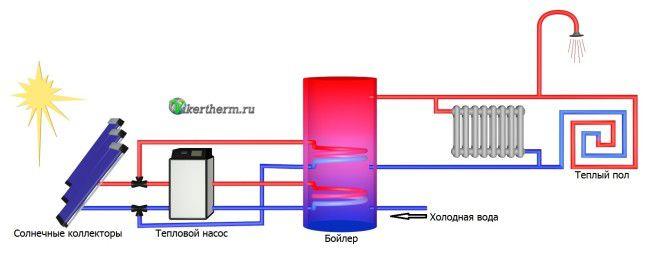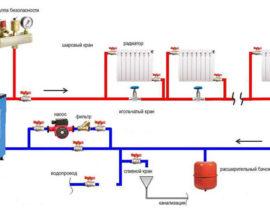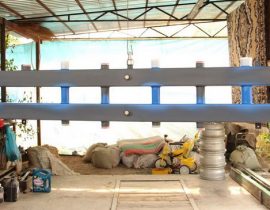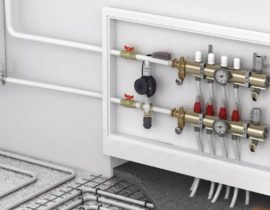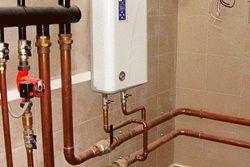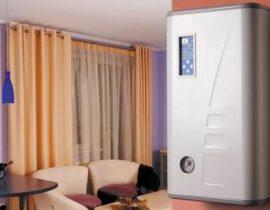Heating systems in private country houses can be built on completely different energy sources. These can be systems based on boilers, in which the heating of the coolant is based on the combustion of various types of fuel, such as gas or liquid diesel fuel. The boilers can be fired with coal or wood pellets. In any case, in order to put such a heating system into operation, in addition to the actual installation of heating boilers, you will also have to purchase the fuel itself. But this item of expenditure can, in a certain situation, even exceed the cost of installing a heating system. This is where solar collectors can come in handy for heating your home.
Content
- Pros and cons of solar collectors for home heating
- Efficiency of solar heating collectors
- Principles of functioning of heating collectors
- Types of heating solar collectors for the home
- How to choose the required type of heating manifold?
- Features to consider when choosing a collector
- Installing a solar heating collector
- Honest reviews about the operation of solar collectors of various models for home heating
- Is it possible to make a really working solar collector with your own hands?
Pros and cons of solar collectors for home heating
The use of renewable energy sources in autonomous heating systems involves financial costs solely for the purchase and installation of such a system, as well as for its maintenance and necessary maintenance repairs. But after installation, such systems begin to work completely autonomously and absolutely free of charge for their owners. In fact, you don’t have to pay anything for the sun’s rays.
Some consumers express doubts about the effectiveness of installing and using solar collectors in central Russia, where there are not so many sunny days as, for example, in the Kuban. However, solar collectors for heating water can be used not only as the main source of heating the coolant, but also as an additional source. In this case, the solar-powered water heating device will only work when there are no clouds in the sky, and in other periods, classic heating devices, such as gas boilers, can be used.
As for the efficiency of using solar collectors in terms of price-return ratio, we recommend that you pay attention to the northern provinces of China. A significant number of houses in these Chinese cities and villages are equipped with solar collectors for heating. The climate and solar activity in these areas is not too different from the adjacent Russian regions: for example, the Khabarovsk and Trans-Baikal Territories. You yourself understand that the climate in Transbaikalia, the place where convicts were exiled in tsarist times, is absolutely not sugary.This means that the use of solar collectors for heating houses, even in Russian regions with the most severe climate, is not only possible, but also quite in demand and economical.
Efficiency of solar heating collectors
It is worth noting that solar collectors have become perhaps the most efficient devices that use solar energy today. If classical solar photovoltaic array can show an efficiency of only up to 18 percent, then a solar collector for heating reaches enviable efficiency rates of up to 95 percent. The difference is obvious.
Principles of functioning of heating collectors
One of the main designs of solar heating collectors are vacuum-type devices. Based on the name, it is obvious that such devices will collect radiant solar energy and transfer it to heat water or other coolant. This is actually how it works in reality.
Autonomous heating systems incorporating solar collectors consist of the following main components:
- Actually solar heating collector - that is, a device that is placed in direct sunlight and serves to heat the coolant,
- Heat exchange circuit: a piping system through which a hot coolant moves, gradually transferring its heat to heated rooms,
- Thermal accumulator: this is a water tank in which heated water is stored for future use.
So the solar collector, consisting of pipes in which there is not yet heated coolant, is exposed to direct sunlight.The coolant fluid (usually water, but possibly special antifreeze) enters the collector, heats up there and is transferred to the heat exchange circuit, which is mounted inside the heat accumulator. The heated coolant, moving inside the pipelines of the heat exchange circuit, heats the water in the heat accumulator. The heated water in the storage tank is stored until it is needed, for example, until it is supplied to the domestic heating circuits and heating radiators or domestic hot water circuits, for example for washing.
Since solar energy acts on the collector completely free of charge, there is heated water in the system at any time, which is heated by a constantly circulating coolant.
Naturally, the heat accumulator tank must have excellent thermal insulation, which helps to maintain the temperature of the heated water for as long as possible. This will avoid a drop in water temperature at night when there is no solar heating or during periods of cloudy weather. To ensure the uninterrupted operation of such a system on very cloudy or rainy days, an ordinary electric water heater can be mounted in the heat accumulator tank.
In order for the coolant to constantly transfer the heat of sunlight to heat water, it must constantly circulate. In systems with solar collectors, the circulation of the heat transfer fluid can be forced (with pumping) or natural (smoke).
Types of heating solar collectors for the home
Modern industry has mastered the production of various types of solar heating collectors.In order to understand which of them may be suitable for installing a home heating system or a hot water circuit in your home, you need to familiarize yourself with their varieties. There are two main types: flat and vacuum, air collectors are less widespread.
Flat light absorbing
A flat heating solar collector is a thin box, inside of which there is a special substance that actively accumulates and absorbs heat. The top of the box is covered with glass, which allows the sun's rays to pass through. Inside the adsorbing layer, which collects heat, there is a system of pipelines, inside which the coolant moves. As a coolant in such systems, as a rule, propylene glycol is used.
Vacuum
Inside the vacuum heating manifold, in place of a single flat box, there are hollow glass or quartz tubes from which air is pumped out, then there is a vacuum created. But already inside such hollow tubes there are tubes with a substance that absorbs solar thermal energy. Accordingly, the pipelines with the coolant are inside the tubes with the adsorber. The sun's rays easily penetrate the vacuum in the gap between the pipes and heat the coolant. However, the same vacuum prevents the reverse leakage of thermal energy from the adsorber into the surrounding space, acting as a heat insulator.
Air
As the name implies, such devices do not have a heat-insulating vacuum layer. Therefore, the efficiency of their action will be lower than that of vacuum collectors.Such devices are recommended to be installed in areas with a large number of sunny days. Moreover, in such collectors, the coolant is ordinary air. It is transferred to a heated room by a fan or natural convection. Fan operation while moving air also requires a separate power supply. This is an additional reason that this system has a lower efficiency than flat or vacuum collectors. Of course, there can be no talk of any hot water supply in such a design.
How to choose the required type of heating manifold?
Each type of solar heating collectors has its obvious advantages and obvious disadvantages. When choosing a device, you should pay attention that a flat collector is a more durable design, but vacuum collectors are very sensitive to external influences due to the presence of hollow air tubes. However, in flat-plate collectors, the entire adsorption system must be replaced during repair, and if one of the tubes of the vacuum collector breaks, it can be limited to just replacing it.
The air collector, for all its shortcomings, is an extremely simple device, and is not critical when exposed to low temperatures. It can work even in the fierce Siberian winter.
A flat-plate collector is ideal for heating water in the range of 20 to 40 degrees higher than the ambient temperature, and vacuum devices have a higher degree of heating of the coolant. Thus, in winter conditions, the vacuum collector will be more efficient, and simply possible to use. They also retain heat better when working in cloudy weather and retain heat energy well in cold weather conditions.However, the overall fragility of the design reduces the life of vacuum solar collectors, which fall short of this indicator to flat devices. The latter, if well made, can last in your home from 15 to 30 years.
Features to consider when choosing a collector
The transfer rate of the radiant solar energy of the sun into the thermal energy of the coolant in a vacuum solar collector directly depends on the size of the tubes of this device. If the collector vacuum tube is short and thin, it will not be able to store vacuum energy efficiently enough. Typically, tubes up to 2 meters long with a diameter of about 6 centimeters are used to complete vacuum solar collectors. A simple straight or curved U-tube can be mounted inside the vacuum tube for more efficient heat collection.
Installing a solar heating collector
The solar heating collector, together with the heat storage system and the heat exchange circuit assembly, is a rather complex technological system. Kits of such equipment are equipped with detailed installation instructions, and detailed video tutorials can also be found on the Internet. But before buying and installing a solar collector, it is necessary to draft a heating system. In this process, it is imperative to involve a specialist who will make the necessary calculations of materials and equipment.
The use of alternative energy sources can significantly reduce the cost of maintaining your home, moreover, it can make you independent of traditional energy suppliers.
Solar collectors for home heating: video
Honest reviews about the operation of solar collectors of various models for home heating
Model KS 2000
Working time - 3 years:
RKraft Model
Working time - 5 years:
Vacuum manifold Altek
1 year of operation:
The efficiency of the vacuum collector in winter:
Chromagen model
Operating experience - 4 years:
Model ATMOSPHERE SVK Nano
On the market since 2013:
Is it possible to make a really working solar collector with your own hands?


